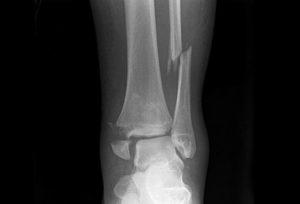
Pott’s fracture, also known as a bimalleolar ankle fracture, is a type of ankle fracture that involves the tibia and fibula bones. It is typically caused by a twisting injury or direct trauma to the ankle.
In a Pott’s fracture, both the medial malleolus (the bony protrusion on the inner side of the ankle) and the lateral malleolus (the bony protrusion on the outer side of the ankle) are fractured. This can cause significant pain, swelling, and difficulty bearing weight on the affected foot.
Treatment for Pott’s fracture typically involves immobilization of the ankle with a cast or brace to allow the bones to heal. In some cases, surgery may be necessary to realign and stabilize the fractured bones. Rehabilitation and physical therapy may also be necessary to regain strength and mobility in the affected ankle.
If left untreated or improperly treated, a Pott’s fracture can lead to long-term complications such as chronic pain, instability of the ankle joint, and an increased risk of developing arthritis in the ankle.
